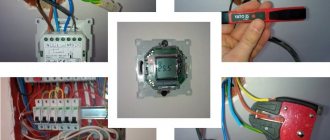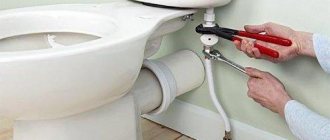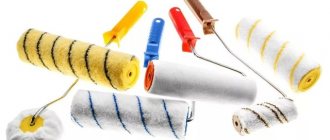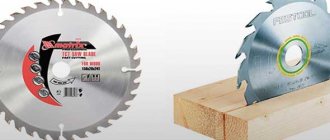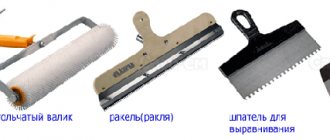5 / 5 ( 1 voice )
The contactor is modular or, as it is often called, a magnetic starter or relay. When used correctly in electrical panel circuits, a modular contactor can be a very useful device, including indispensable when designing automatic transfer switches.
In my electrical panels, as a rule, I use a contactor to remotely (remotely) turn off/on consumers. For example, for controlling non-switchable lines in an apartment or private house, as well as for controlling heating systems together with the GSM controller “Xital” and other similar relays that can command the contactor to turn on or off remotely using GSM communication.
In production, contactors (magnetic starters) are usually used to control motors, pumps, and also in remote control circuits for many other devices and lighting.
Design and principle of operation
You can connect magnetic starters and contactors yourself; you just need to understand the principle of operation of the devices and how to configure the circuits. The magnetic starter consists of a magnetic core and an inductor coil. The magnetic wire has two parts, movable and non-movable , the first is fixed on a spring and carries out free movement, and the second is installed on the body of the device and is motionless.
A coil is installed in the hole of the second part; its location affects the rated contactors of the starter with a coil; they are divided into 12 V and 24 V, 110 V and 220 V and 380 V. And the second part is used for moving and fixed contacts. If power is not supplied, the first part is pressed out by springs, and the state of the contacts does not change and remains in its original form.
As soon as voltage appears, when the start button is pressed or another supply of electricity, the coil regulates the generation of an electromagnetic field, in which the first part of the device is attracted and the arrangement of the contacts changes.
If the voltage disappears, the electromagnetic field zone dries up, the spring part is pressed upward in the moving side of the contactor, and the state of the contacts returns to their original form. This is how an electromagnetic starter works: voltage appears in the contacts, a short circuit occurs, disappears, and an opening occurs. Constant or variable voltage devices are connected to the contact device.
But you need to monitor the device parameters so that they do not exceed those stated in the instructions for use.
Starters are divided into two types with normal closed contacts and normal open contacts. From this you can understand how they work, the first turn off the voltage, and the second turn on; in order for power to be supplied, you need to use number two, and in order to suppress the first.
Contactor selection
How to choose the right contactor or starter?
A modern modular contactor is no longer the bulky equipment it used to be.
It is compact (mounted on a DIN rail) and has no annoying noise during operation.
When choosing, first of all pay attention to the rated current. The most popular ones are 20A, 40A, 63A.
The contactor must calmly pass through itself not only the entire load connected through it, but also not melt if it is briefly exceeded. He doesn't have his own protection.
Mistake #2
Therefore, it is impossible for the rated current of the contactor to be less than the current of the input circuit breaker.
It is desirable that it exceed its value by one step. For example, a 25A or 32A machine – a 40A contactor; automatic 50A – contactor 63A, etc.
The current for which the contacts are designed can be found on the equipment body.
This inscription means that the device has two rows of contacts, designed for a maximum current of 20A on each pair.
That is, in total you can connect a load of 40A or ~ 8 kW to it.
Mistake #3
But this does not mean at all that it will be suitable for an input circuit breaker of 25A or 32A.
Also pay attention to other inscriptions and designations. For example, the letter “S” indicates that this is low-noise equipment.
Hager has such a series. For a house with a panel room indoors, it is advisable to buy silent models.
Where and why it is used
Electromagnetic starters and contactors are built into a power network that transports current; it can be direct or alternating voltage; the work is used on electromagnetic induction. The devices are equipped with a set of signal contacts, through which the connected devices are powered. Some perform an auxiliary function, while others perform a working function.
Electrical installations and electric motors are controlled by starters, but do not protect them in the event of a voltage drop, since the power contact opens, and the operation of the device to which the electromagnet is distributed is suspended and independent activation is excluded.
To put the equipment into operation, you need to use the “start” button. This ensures safety, since accidents may occur due to spontaneous activation.
The starter connection circuits may include relays with thermal action; they are designed to protect electric motors and other installations from long-term operation. There are single-pole and double-pole magnetic starters. They are triggered when exposed to a current overload of motors through which voltage passes.
Light control from several places
The task is simple: turn off the light either from the entrance to the apartment or, for example, from the bedroom. Here we need a pulse relay that changes state, receiving a 230V pulse from any source. Here's how it works:
There are two pulse relays in this circuit, because the apartment light hangs on two different phases, they must be connected through different relays. Or you can use a pulse relay with two groups of contacts. 230V is supplied to the master switches, they supply an impulse to the relay to change the state. There can be as many master switches in this circuit as you like.
You can replace one of the master switches with a card switch, and the other with a key reader, whichever is more convenient.
You can use a keypad as a control device, on which you need to enter a 4- or 5-digit code to turn the light on and off, but this is less convenient.
37, total, today
4+ I design Smart Home systems, low-current systems, and electrical systems. Descriptions of tasks and questions can be sent to [email protected] More details (in particular, cost) can be read.
Main characteristics
In order for the starter to work correctly, you need to follow certain installation rules, know the basics of devices with relays and select magnetic and reversing device circuits. Contactors and starters operate for a short time and devices with an open contact are most often used. Some have a signal circuit built into them and are designed for devices with consumption from 0.28 to 12 kilowatts, others for from 5 to 70 kilowatts and are capable of operating with a voltage distribution of 220 or 380 V.
Device options are divided into:
- open;
- protected;
- dust- and water-proof;
- dust-splash-proof form.
The PME starter contains a TRN “relay”, and the PAE model differs in the number of relays. If full voltage is supplied, the device's coils operate reliably. the main part of the devices has nodes:
- core;
- electromagnetic coil;
- anchor;
- frame;
- mechanical sensor;
- contact groups, central and additional.
The design may include an additional assembly consisting of a protective relay, an electrical fuse, an additional terminal set and a starting device.
The electromagnetic coil with turns is designed to transmit voltage up to 650 V. The coil is located in the heart, and most of the power is distributed to the power part of the springs. In the normal state, the contact is open and the springs are held in the upper position and hold the magnetic conductive sections.
There are starters that limit overvoltage; they are used for semiconductor systems. The coil begins operation of the alternating current system; the type of current and characteristic do not affect the operation of the installation.
Price overview
You can buy a modular contactor in any city in the Russian Federation and CIS countries; the price depends on the model and brand of the device.
| City | Cost of TDM KM63/2, USD e. |
| Voronezh | 20 |
| Ekaterinburg | 21 |
| Kyiv | 23 |
| Krasnodar | 20 |
| Nizhny Novgorod | 21 |
| Novosibirsk | 21 |
| Tyumen | 21 |
| St. Petersburg (SPb) | 23 |
Before purchasing, be sure to check the contactor passport and quality certificate of conformity.
5 starter connection diagrams, connection diagram via start and stop buttons
To connect the circuits, two “Start” and “Stop” keys are needed, each is produced in a separate case or in a single one, the operation of the device does not change from this and is called a push-button station.
If the buttons are located separately, then no questions arise, one contact is supplying power, the other is decreasing. And if the buttons are in the same case, then they each have 2 groups of contact lines, two for “Start” and two for “Stop”, each group has its own side. There is a compartment with a terminal for monitoring the current supply.
Connection diagrams for magnetic starters with 220 V coils - single-phase network and connection, simple option. 220 V is supplied to the upper and lower coils, which are located in the body of the device. A cord with a power input is connected to the wires; as soon as the plug is in the socket, the starter will begin operating. It is activated with any voltage, and is removed when the starter with contacts t1-t3 is activated.
Setting schemes using the “Start” and “Stop” buttons . The starter is used for electric motors; operation is convenient when there are “Start” and “Stop” buttons. For continuous operation of the devices, they are alternated by supplying phases to a magnetic coil. The starter operates only when the “Start” button is pressed, that is, it is not suitable for constant operation of the device. You can add self-retaining to the circuit; the work occurs with auxiliary contacts that can be installed on some types of devices.
Schemes for connecting 380 V asynchronous motors to 220 V starters - connecting three phases to contact wires and distributing the load along them. These are starters with a thermal relay; it functions to protect the motor from heating.
Reversible connection diagrams - used when it is necessary to ensure rotation of motors in opposite directions. The direction changes when the phase is transferred; the circuit contains two starters and a button block in which the “stop”, “forward” and “backward” keys are located.
The power circuits for connecting the contactor-phase are switched by redirection when the motors rotate, everything is controlled by the power circuit. When the contacts are triggered, a signal comes to the coil, for each of its own, only three phases, the engine runs in the left direction. Phase c is on the third winding, b is on b, and no changes occur in phase number one. In this case, the motor will move to the right.
The circuits are not complicated, but the reversible one requires double-sided protection so that there is no back-to-back switching. Divided into mechanical interlocking and contact protection.
Standard heating kit
The standard heating ceiling kit includes infrared electric heaters (heating film TM, ZEBRA EVO-300, etc.), contact wires, an electrical panel with switching equipment and thermostats. The number of thermostats depends on the presence of temperature zones within the room that are served by the heating system.
Each thermostat is designed for a certain power and current, which must not be exceeded. This affects the longevity of the system, its efficiency and safety. For example, we recommend connecting the Cewal RQ30 thermostat directly with a power of up to 1.5 kW (7 A).
Direct connection of the Eberle thermostat to the heater
The simplest and most common installation scheme is to connect the heater's power cable directly to the Eberle thermostat.
It is enough to apply electric current and adjust the temperature of the regulator for the circuit to work. The principle is simple: Power from a source, for example, an electrical panel, enters the thermostat, where, depending on the ambient temperature, it is either transferred to the heater or not.
If you know in advance that you will use electric heating and have chosen a location for installing the heater, this is your option. At the same time, it is convenient to hide all the wiring and avoid unnecessary connections.
Features of slot machines of some famous brands
Brands of switchboards for home and business electrical networks produce devices with memorable features. Before purchasing, you should clarify the features of the equipment:
- The Chinese brand "Energy" presents 2 series. 46-73 has no indicators or recesses, suitable for 6 kA current. VA 47-29 – with side recesses, double-sided comb, 6 kA.
- The manufacturer EKF offers devices from the Proxima line with plugs for seals. Budget machines 47-63 come without them.
- The products of the Kursk company KEAZ are easily distinguished by their place of production. Russian VM-63 are suitable for seals, combs, and have contact indication. Chinese VA 47-29 are rated at 4.5 kA, without indicators and holes for the comb.
- Heavy Hungarian GEs are designed for a current of 6 kA and do not have recesses on the sides. Comb area on one side.
- Polish Legrand TX switches for current 6 kA with recesses, but without indicators and combs.
- You can identify the place of production of Shneider Electric by its power. Bulgarian ones are suitable for current from 25 A, everything below is made in China. The Easy 9 series are good inexpensive single-pole models.
- ABB S series products (6 kA) have an indicator, notches, and a one-sided comb. SH switches (4.5 kA) come without combs and indicators, but with recesses.
Electrical installation
A typical circuit for assembling an electrical panel begins with an input device, which in this case is best suited for a differential automatic device. Its output terminals are connected by jumpers to the cross-module, from which further wiring is performed. Since contactors are not designed to protect against short-circuit currents, for optimal layout of electrical devices it is better to use double-row panels. In the top row, the required number of circuit breakers is installed to protect each line. Directly under each of the machines, a corresponding contactor is installed, to which the phase conductor of the line it controls is connected. When connecting the power cables of the convectors, the protective and working neutral conductors are not combined at any point in the circuit; they are routed to different blocks of the cross-module.
Connection diagram for electric convectors: 1 - input automatic; 2 - counter; 3 — RCD/difavtomat; 4 — cross-module; 5 - automatic switch; 6 — thermostat; 7 — air temperature sensor; 8 - contactor; 9 - electric convector
The situation becomes more complicated in cases where control devices are also mounted in a modular panel. These can be either programmable thermal relays with a remote sensor, or remote control devices (Xital) or logical controllers (CCU). In such cases, the panel should be three-row: in the top row, an input device is installed along with control and automation devices, the bottom two are allocated to accommodate circuit breakers with contactors.
Since the power lines of convectors are of a stationary type, they should be made with a cable with single-wire conductors in vinyl insulation. Such conductors do not require crimping to connect to the terminals; simply strip them and roll them into a ring. If the number of controlled lines is more than two, it is highly advisable to carry out marking: a belt tag is attached to the place where the cable enters the shield, while the phase conductor is crimped with a corresponding cable tag at the end.
The control circuit wiring, as mentioned, is represented by a cable with three or more cores. Neutral (blue) is connected to the corresponding block of the cross-module, phase - to the output of the low-current circuit breaker. The remaining conductors, according to the markings, are connected to the terminals of the contactor coils, designated by the letter A with index 1 or 2. The second terminal is connected by a jumper to the neutral block of the cross-module.
Note: this connection is correct only if the supply voltage to the contactor coils is mains; if 24 or 36 V devices are used, the circuit is supplemented with a step-down transformer. In this case, an additional core must be provided in the signal cable going to the thermostat, through which a reduced voltage is supplied to the middle point of the contacts of the relay group of the thermostat.
Installation Tips
Some tips:
- Before purchasing a TR, you need to make sure that the characteristics of the regulator and heating elements are compatible.
- You need to choose to install the device in the most accessible location.
- When deciding whether to purchase a device, you should evaluate the economic feasibility of using a specific thermostat model.
- If you do not have enough experience in installing such devices, then it is better to seek help from specialists.
A person sometimes has no idea about the number of thermoregulatory devices around him. They became a part of everyday life. Their work brings significant savings in energy costs.



